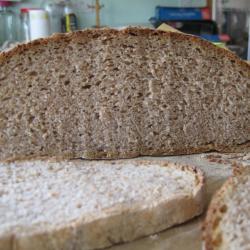
/* Style Definitions */ table.MsoNormalTable {mso-style-name:"Table Normal"; mso-tstyle-rowband-size:0; mso-tstyle-colband-size:0; mso-style-noshow:yes; mso-style-priority:99; mso-style-qformat:yes; mso-style-parent:""; mso-padding-alt:0cm 5.4pt 0cm 5.4pt; mso-para-margin-top:0cm; mso-para-margin-right:0cm; mso-para-margin-bottom:10.0pt; mso-para-margin-left:0cm; line-height:115%; mso-pagination:widow-orphan; font-size:11.0pt; font-family:"Calibri","sans-serif"; mso-ascii-font-family:Calibri; mso-ascii-theme-font:minor-latin; mso-fareast-font-family:"Times New Roman"; mso-fareast-theme-font:minor-fareast; mso-hansi-font-family:Calibri; mso-hansi-theme-font:minor-latin;}
Hi there! This is my first post here and I wanted to share with you my semi-success and also hopefully draw on your expertise to get my bread even better next time.
So after days spent tweaking my starter (much to the confusion of my parents, “what on earth is that jar of stuff in the airing cupboard?!”) I finally had something which was happily bubbling away and had a pleasant fruity/alcoholic aroma (as opposed to the less pleasant vomit aroma that starter no.1 produced). I made it with a 50:50 mix of organic wholegrain and plain bread flours.
The recipe I followed was one from a cookbook which called for a sponge to be made the night before using 100ml of starter, 250g flour (which was about 2/3 plain and 1/3 wholegrain) and 250ml water. To make the final dough I added 300g of the same flour mix, 10g salt and a tablespoon of olive oil. I only had a few minutes to make up the dough before I had to go out so I barely had time to knead it, probably only 2-3 minutes. When I came back 2 hours later it had risen a fairly decent amount though maybe not quite doubled. I stretched it and folded it over and then left it for about 7 hours at room temp.
The result:


Well I can definitely see why it's called sourdough! My mum thought I must have spiked it with some lemon juice to give it its flavour. Personally, although I love sour things, I found it a bit too sharp for what I'd want in a bread. Is there any way to make this flavour a bit milder?
My main problem with the bread though is how heavy it was. I was hoping for something much lighter with loads of big, irregular holes in it but what I got was something much more dense and uniform. Should I have just left it for longer to rise? Or was it always going to be dense because I put wholewheat flour in? Anyway, overall I was pretty pleased with it and think it was a decent first try. My starters still bubbling away so I'm looking forward to starting on the sequel!

Replies
I'd call that a success!
Hmm, lots to chew on from your formula. But, here's a few quick observations...I'll leave the technicalities to others ;)
Could I confirm with you on your formula's water content? There isn't any addition in the final dough other than that in your sponge? That would roughly work out to 50% total dough hydration (assuming your starter is 100% hydration)....300g water/600g flours...pretty stiff. You could increase them hole sizes with a wetter dough, say, 70%. And, I'd do a couple more very gentle stretch and folds. Your wholemeal flour only constitutes a third of your flours, so holes can still happen.
On the sourness...that is a lot of sponge (making up half the total dough recipe) sitting overnight. AND, you proofed your bread for 7 hours...that's a lot of time to develop sourness. You could either try reducing your overnight sponge to 30% of the formula, or, shortening your proofing time to 4 hours. Or stick it into the fridge to slow down the chemical breakdown if you are going to be out for a longer time than that. If you can allow it one hour at room temp before retarding in the fridge, even better.
Happy baking!!
Thanks for the reply Teckpoh! I'm going to bake by next loaf tomorrow so I'm following your advice and decreasing the amount of starter. I was just wondering if you wouldn't mind explaining something to me though. This is probably a really basic question but I've to ask! What is the point of punching down the dough after the first rise and before you shape the dough and proove it? Surely you're just getting rid of all the air. How come you don't just shape it at the beginning and let it rise once for a long time and then bake? Thanks a lot
but...but...we don't punch down our dough...at least most of us here I believe. Sourdough chemistry works at a slower pace than baker's yeast, so you don't need to slow it down (further) by aggressive degassing. In fact, I can't stress more on a gentle touch...do your stretch and folds (S n F) gen..tel...ly. Unless. Unless you want a bread with close crumb. Most bread doughs improve with S n Fs, but, breads with low glutenin like rye bread, or, a stiff (and strong) dough, can be shaped right from the start.
Sorry for the late reply...had to rush for my Pilates class. I actually typed the reply and pressed the Save button, but, it got lost somehow.
I really appreciated your last post as I have had the very same problems and questions as Sharky, thank you
Here's 11 tips on how to tone down your sourdough.
http://www.sourdoughlibrary.org/less-sour-sourdough/